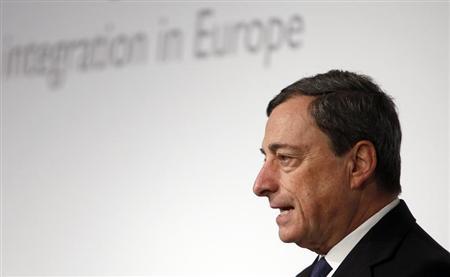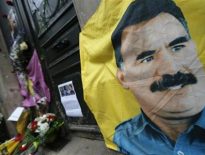(Reuters) – The European Central Bank is expected to keep interest rates unchanged on Thursday but investors will be looking for any signs it is preparing for a cut in coming months to help lift the euro zoneout of recession.

Despite a recent drop in economic sentiment and falling inflation, a Reuters poll of 73 economists showed little change in expectations, with rates set to remain at 0.75 percent – tiny, but still the highest level among the world’s major central banks.
As the world recovers from the financial crisis, the ECB has lent less support to the economy than its peers in Japan, the United States or Britain, who have launched massive asset purchase programs and cut rates closer to zero.
Japan went a step further on Thursday. The Bank of Japan’s new governor, Haruhiko Kuroda, shocked markets with a radical overhaul of its policymaking, adopting a new balance sheet target and pledging to double its government bond holdings in two years as it seeks to end nearly two decades of deflation.
The unexpected scope of the changes drove the yen lower and knocked the 10-year bond yield to its lowest in a decade.
Earlier in the week, ECB Executive Board member Benoit Coeure had warned against countries directly pursuing overt competitive devaluations, especially if other central banks had limited room to maneuver.
Japan’s moves are designed to push inflation higher, lifting the country out of decades of deflation and minimal growth.
Less is expected of central bank meetings in Europe where the Bank of England concludes its policy meeting at 1100 GMT and is expected to wait with further bond buys.
The ECB itself is unlikely to go down a similar path to its international peers at its policy meeting, which began early on Thursday, not even to boost lending to households and companies in the euro zone periphery, which so far enjoy limited benefit from record-low ECB rates.
“Apart perhaps from loosening some of the collateral rules again, we don’t expect that the ECB is yet ready to launch into any programs in terms of purchases of assets,” said Citi economist Guillaume Menuet.
“The Governing Council will be mulling over a change of tone to prepare investors for an easing of monetary policy later in the quarter,” said Menuet, who had penciled in a 25-basis point cut in the main refinancing rate for May or June.
RECOVERY STALLS
After early signs of stabilization in the euro zone economy at the start of the year, March marked a set back as Cyprus narrowly escaped a financial meltdown by securing a last-minute bailout and Italy struggled to end a post-election deadlock.
Euro zone economic sentiment fell after four months of gains, surveys showed manufacturing across the bloc fell deeper into decline and inflation eased to 1.7 percent, departing further from the ECB’s target of below, but close to 2 percent.
One month’s readings will not be enough to change the ECB’s policy stance, but any indication of heightened concern about growth prospects or the inflation outlook will not go unnoticed ECB President Mario Draghi’s post-meeting news conference.
Draghi will also likely be asked by journalists whether the Cyprus rescue deal that for the first time penalized large bank depositors will serve as a model for future bank bailouts, something some ECB policymakers have denied.
ECB Governing Council member Ewald Nowotny two weeks ago doused hopes for further cuts, saying in the current situation lower interest rates would not have much of an effect. His colleague, Yves Mersch, made similar comments last week.
The ECB’s main worry is that its low rates are not reaching households and firms in the euro zone periphery, mainly because banks’ funding costs in crisis stricken countries are higher than those in the core countries, pushing up loan costs.
This affects small and medium-sized enterprises (SMEs) in particular as they have few alternatives to bank funding.
Draghi said after the March policy meeting that the ECB was studying options to address the issue, but that they were not planning “anything special”. Since then, several policymakers have said a number of options were being looked at.
Nowotny said one plan was to package SME loans, but rejected suggestions the central bank could buy them directly, saying instead that the ECB would work through the banking system.
(Editing by Jeremy Gaunt.)





